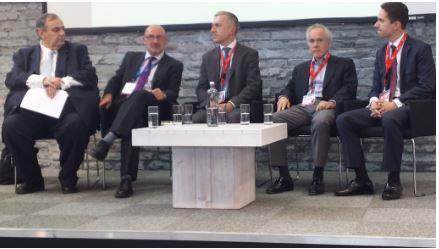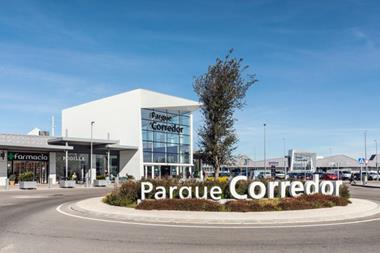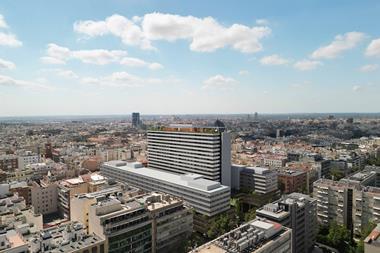Ecommerce is growing and transforming so fast that it will likely become a separate asset class, a PropertyEU investment briefing at the Provada real estate fair in Amsterdam has heard.

'It wouldn't surprise me if ecommerce becomes a separate asset class,' said Tim Davis, director of industrial and logistics at Colliers International. 'Ecommerce is moving so fast,' he told the Ecommerce and the Logistics of the Future briefing at the International Business Lounge on the first day of the Dutch real estate fair on Tuesday. 'The internet revolution has completely changed the logistics sector.'
Sweeping changes across the industry triggered by Amazon's demand for XXL boxes on the one hand and smaller fulfilment and parcel delivery centres on the other, have also caused yields to move in to levels seen in retail real estate, Arthur Tielens, managing director of logistics for Patrizia, told the briefing. In Germany yields for e-commerce-related properties have tightened to just over 5% while in the UK they have dipped even lower to 4.7%, he noted.
Patrizia is focusing on both smaller delivery centres of under 20,000 m2 as well as medium-sized warehouses of above 20,000 m2, Tielens said. Prices of smaller warehouses range from €5-€20 mln, he pointed out. 'If you want to build a €1 bn fund like we do, it would take too long to focus only on the smaller assets,' he said.
The market is indeed seeing polarisation between the mega distribution centres and the smaller parcel fulfilment centres, according to René Buck, director of Buck Consultants International. Pointing to recent research conducted by his firm, Buck noted that the Netherlands has witnessed the establishment of 28 new large distribution centres (with each measuring more than 40,000 m2) since 2013. In total these centres account for 2 million m2, generating jobs for more than 10,000 people.
The bulk - or 46% - of these big boxes are located in the southern Dutch province of Noord-Brabant, specifically in the Tilburg-Waalwijk area. Most of these XXL distribution centres are being developed by retailers/on-line shops such as Primark, Action, Lidl, Bol.com, manufacturers or brand owners such as Tesla, Michael Kors, and logistics providers such as Rhenus, DB Schenker and Arvato, Buck said.
'Economies of scale is an important driver, to facilitate the use of the newest technology, the efficient use of staff and to combine deliveries. More space is needed for both "traditional" store chains with growing online sales as well as the pure online retailers to facilitate the presence of sufficient stock of a wide product range and to package all individual orders. A lot of space is also needed to unpack goods that consumers have returned, to inspect them and make them ready for reshipment.'
'LAST MILE'
The metrics and economies of XXL big-box centres are well understood but logistics developers, investors and ecommerce retailers are still grappling with e-commerce's need for urban facilities. These centres form the last link in the chain for speedy deliveries to the customer - the part customers have the most complaints about. To operate effectively these facilities have to be located close to metropolitan areas where land values tend to be higher than those for bigger centres located further away from cities. And, as a result rents are higher too.
'I don't think anyone has fully figured out the "last mile",' said Anthony Wirth, head of EMEA logistics strategy & research at CBRE Global Investors. Buck agreed, saying that the 'last mile' is being dealt with differently in different markets. One potential solution is to develop multi-storey delivery centres in urban areas, yet the rent levels that can be achieved by a developer don't compare well with residential or other property sectors in the city. Nevertheless, the higher rents for urban distribution centres cut into the margins for ecommerce retailers and their distribution networks. 'The major issue everywhere is that nobody wants to be the one to pay for the deliveries,' Buck noted.
Ecommerce has nevertheless totally changed the face of high-street retail as rents for warehouses used for e-commerce tend to be 20% of the levels commanded by high-street locations, Davis said.
ROBOTICS
Ecommerce may be growing fast and developing into a separate logistics asset class, the briefing heard, but it is currently make up to 30% of the overall market. The three most mature e-commerce markets are the US, China and the UK. The Netherlands (where internet penetration is up to 98%) and Belgium are improving.
Germany, however, was singled out by Artur Mokrzycki, head of capital markets Panattoni Europe, as the best of both the traditional and ecommerce logistics worlds. Germany is both the geographical centre and economic powerhouse of continental Europe and CEE countries are benefitting from their close proximity. 'You can see bottles of mineral water, consumer electronics to plane parts in warehouses in Germany and Romania. These countries are still able to manufacture products. And, countries in Central and Eastern Europe are in effect sub-contractors for the German market,' he said.
E-commerce is adding to the sector in this region. Amazon has three massive distribution centres in CEE, each employing 3-4,000 people. Yet, automation is a growing factor. 'I was surprised how robotics have come so quickly to logistics centres in CEE as I thought it would make more sense in markets like Germany where labour costs are higher,' Mokrzycki said.










